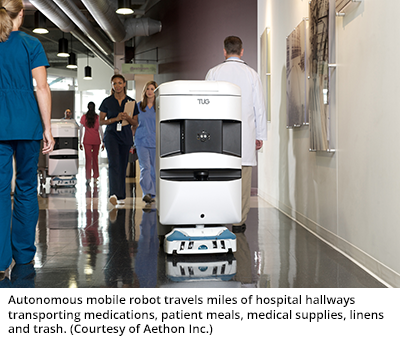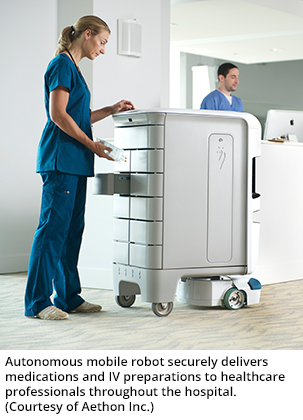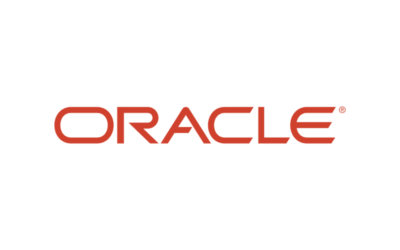For the entire online article as posted on the RIA webiste –> Go Here
Mobile Robots on Call
Mobile robotics is another booming area not only on the industrial side, but now it’s also accelerating in healthcare. Adept Technology with its Lynx® Autonomous Intelligent Vehicle, Amazon Robotics with its fleet of 30,000 Kiva robots, and startups such as Fetch Robotics are reorganizing the logistics space.
“Once technology is proven in industry, the medical side of things usually picks up pretty quickly,” says KUKA’s Ryan. “There are already systems moving medical charts and medications around hospitals. Our LBR robot is portable. We definitely have people that are interested in the ability to move it. And the next question is always can I automate the motion? Can I just have them push a button and it will move to OR 4? That will come. Customers are already looking into it.”
The mobile transport robots Ryan referred to have been racking up the miles in hospitals for over a decade. Consider these statistics. In a typical week, a 200-bed hospital has to move 10,000 medication orders, 4,500 meals, 83,000 pounds of linens, and 70,000 pounds of trash. That’s healthcare workers clocking 370 miles a week moving this stuff around the hospital.

Now substitute a robot into that scenario. You will find that one mobile robot maker has a lot of miles on it. Not an acronym but more in the spirit of a tugboat, the TUG made by Aethon Inc. is an autonomous mobile robot designed to transport the tons of goods and supplies that keep a hospital running.
“Hospitals are starting to realize that they’ve done a lot to manage the logistics from outside of their building to their dock, but they’ve done very little to manage the logistics inside of their organization,” says Tony Melanson, Vice President of Marketing for Aethon. “That’s what we call intralogistics.
“So when a nurse is waiting for something, or they’re trying to get a room turned over, or a patient is waiting for a meal, or they’re trying to get medication to a patient, you’re in this indoor city and you’re trying to move all this stuff around. Nurses are waiting and patients are waiting. All of those things come into play when you look at the big picture.”
Established in 2001, Aethon deployed its first TUG in 2004. Now TUGs are operating in 125 hospitals with the largest fleet of 25 robots traversing the halls of the UCSF Medical Center.
See the Bay Area TUGs in action.
It may sound simple, but beyond its 1,000-pound payload capacity, the TUG houses some sophisticated technology under the hood. Multiple sensors, including sonar, infrared and a SICK laser scanner, help it navigate autonomously and safely among its biped coworkers and hospital visitors.
TUGs travel the same hallways you would use when visiting your loved one in the hospital. Unlike AGVs (automated guided vehicles), the TUG is fully autonomous. It freely navigates hospital corridors and service areas without needing to follow magnets or painted stripes on the floor, or requiring any special infrastructure.
From Ward to Command Center
Melanson says other onboard and remote technologies make the TUG unique in this space.
“Because we’ve been in the hospital space for so long, we’ve developed a lot of enabling technology,” explains Melanson. “It’s one thing to have a robot go down the hallway from point A to point B. It’s entirely another thing for the robot to be able to control elevator systems, or to respond to alarm conditions, or to be able to have two-way communication with the users. Or to have a fleet of robots that are interchangeable among departments, sharing duties and managing when those robots are dispatched, what their next job is, and whether they are dedicated to a certain department at certain times of the day.”
One of those primary enabling technologies is a 24-hour remote command center at Aethon’s headquarters in Pittsburgh, Pennsylvania.
“We have over 450 robots installed in the field,” says Melanson. “One of the things that has allowed us to manage that type of customer base and to be successful is our cloud command center, which allows us to stay connected to all the robots that are installed in the customer base. So if a robot encounters a problem, an algorithm detects the problem and our support technicians here can respond to that condition. The result being that over 97 percent of all alerts that the robots make to the command center can be resolved remotely without any involvement by the customer on site.”
Aethon’s command center operates 24 hours a day, 365 days a year. The remote support comes with every TUG, whether it’s purchased outright or leased.
“Let’s say a bed is across a hallway and the robot can’t get around it,” explains Melanson. “We get a signal and we’re able to either address the problem remotely or in the three percent of situations where we can’t deal with it remotely, we can dispatch one of the customer employees to move the bed or move the robot.”
He says all of the communication is through Wi-Fi and there’s also a secure VPN channel that connects to the remote command center over the Internet.
“It’s really a very important part of our technology platform, because to make an autonomous robot commercially viable, meaning it is affordable enough to purchase because it has return on investment, you can’t necessarily build every single recovery mode into the robot that would be necessary in the field. It would just become too expensive and too complicated. We use our own people internally to address those edge cases.”
At initial deployment, Aethon creates a shared, common map of the hospital and a route definition for all the robots in the hospital’s fleet. Down the road if a route changes, someone in the support center can make the adjustment.
“We can very quickly and very flexibly change, update, and improve the routes and the stops for the robot fleet. The customer doesn’t have to make any infrastructure changes or re-mapping themselves,” says Melanson. “We can do it from here (Pittsburgh command center) and all the robots will know about it.

“The same TUG can deliver clean linen and then turn around and deliver food, but most customers separate the TUGs among departments,” explains Melanson. “The exception to this is the TUG that has our integrated carts with the biometrics. Those TUGs are dedicated to delivering laboratory specimens or pharmaceuticals.”
Robot Rx
President and CEO Aldo Zini, who joined Aethon shortly after it was established, has roots at Automated Healthcare, which developed the first robotic medication dispensing system for hospitals, ROBOT-Rx. It was later acquired by multibillion-dollar pharmaceutical distributor McKesson Corporation. Building on his experience, Zini was one of the catalysts behind MedEx™, Aethon’s software solution for securing and tracking medication deliveries in real time.
Melanson says there’s a black hole between when a medication is ordered and when it’s delivered to the designated patient.
“That is the preparation, who got the medication when it left the pharmacy, who received it when it got to the nursing unit, and where it went from there. None of that is tracked today.
“One of the number one sources of medication errors are interruptions and distractions,” explains Melanson. “And one of the number one sources of interruptions and distractions, for the pharmacy in particular, are phone calls.
“That’s the nurse calling the pharmacy asking, where’s my medication? So we inserted hardware and software in that black hole, so that every single step along the way the medication has a chain of custody. Now everything is visible. They don’t have to make the phone calls, because all they have to do is look at a screen and it will tell them the status of exactly where the medication is and who received it.
“We have helped hospitals that receive 200 missing medication requests a day,” adds Melanson. “Now they’re down to 10 a day. When you can reduce the amount of calls, you can really improve the safety of medication preparation and ordering.”
Combatting Rising Healthcare Costs
Safety and efficiency accompany the TUG wherever it goes. In a beleaguered healthcare industry, administrators are looking around every corner for ways to cut costs.
“We tend to see ROI in the 18-month range,” says Melanson. “That’s plenty short enough for a hospital to get their benefit.”
He says ROI is largely measured in labor savings. When constructing new buildings, hospitals can deploy TUGs in lieu of hiring labor. But it also has a lot to do with the kinds of tasks healthcare staff can do when they’re not burdened with moving supplies around the hospital.
“So in the case of the pharmacy, the people that deliver things by hand can now be in the pharmacy working on preparing medications for the patients,” explains Melanson. “There’s value there when you have people doing work at the top of their pay grade.”
Another area of savings is in worker’s comp costs and safety issues. This draws an interesting parallel with the industrial sector where there’s a strong motivation to robotize the dull, dirty and dangerous jobs.
“Compared to industry, hospitals have four times the rate of days lost due to illness and injury,” says Melanson. “Part of this is due to running around the hospital with these very large carts pulling very large loads, and sometimes pulling two of them at a time. You have back and wrist injuries, and repetitive stress injuries. There are real cost savings related to reducing those types of injuries.”
Melanson also cites the cost of turnover, noting that these kinds of undesirable service jobs have 30 percent turnover. “If you can reduce the churn of replacing people, those are very real costs that can be avoided.”
So what’s ahead for the TUG? Melanson says Aethon is looking to grow internationally in both the healthcare and non-healthcare sectors. TUGs also roam the aisleways of the industrial and logistics space.
“We have TUGs in Denmark, Australia and Germany,” says Melanson. “And soon to be in Singapore and China.”
Aethon is also working on new technology. Currently, the TUG gets its locomotion from two wheels on a rotating head located at the front of the vehicle. Those two wheels pull the entire load. Aethon is testing an additional platform with an omnidirectional base with four independently motored wheels that will allow it to pivot on its own axis and move sideways and diagonally, providing for more maneuverability when needed.





